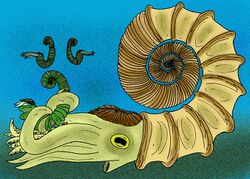Biology:Tropaeum
From HandWiki
Short description: Genus of molluscs (fossil)
| Tropaeum Temporal range: Early Cretaceous
| |
|---|---|

| |
| Tropaeum imperator | |
| Scientific classification | |
| Domain: | Eukaryota |
| Kingdom: | Animalia |
| Phylum: | Mollusca |
| Class: | Cephalopoda |
| Subclass: | †Ammonoidea |
| Order: | †Ammonitida |
| Suborder: | †Ancyloceratina |
| Family: | †Ancyloceratidae |
| Genus: | †Tropaeum Sowerby, 1837 |
| Species | |
| |
Tropaeum is an extinct genus of ammonites found throughout the oceans of the world during the Early Cretaceous. As with many other members of the family Ancyloceratidae, there was a trend among species within this genus to uncoil somewhat, in a very similar manner to the genus Lytoceras. The largest species, T. imperator of Australia , had a shell a little over one meter in diameter.
The name "Tropaeum" was applied by paleontologist James De Carle Sowerby, in 1837.
References
External links
- photograph of the holotype of T. imperator [1][no|permanent dead link|dead link}}]
Wikidata ☰ Q12268226 entry
 |

